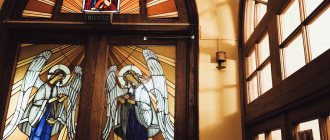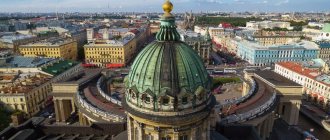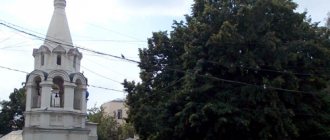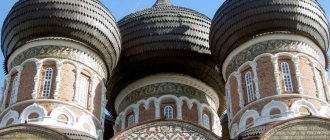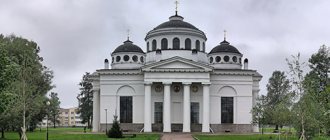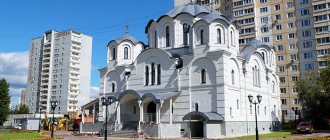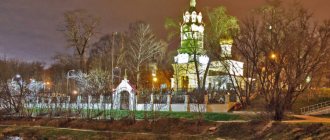Current state and activities of the parish
Today, the Church of the Smolensk Mother of God has three altars:
- The first and main one was consecrated in honor of the Smolensk Icon of the Mother of God.
- The second is in honor of the icon of the Mother of God “Merciful”.
- The third is in honor of Saint Blessed Xenia of Petersburg.
Only the Nativity chapel of the church does not have a separate altar.
Interior of the Church of the Smolensk Icon of the Mother of God (northern throne)
Clergymen try to help not only parishioners in the church. They go to the seriously ill, to those in prison and perform the Sacraments of Communion and Confession there.
There is a parish school for children at the church, where they are taught the Law of God, the Church Slavonic language and church singing. Adults can attend catechism discussions and learn about the history of the church. In turn, believers voluntarily help the temple in whatever way they can.
Church in the name of the Smolensk Icon of the Mother of God on Vasilyevsky Island
Officially, the Smolensk Cemetery was established on October 23, 1738, by a resolution of the Holy Synod: on Vasilyevsky Island near the Black River (as Smolenka was then called), between lines 18 and 23, to clear a place for a cemetery.
In 1758, under Empress Elizabeth, the wooden Smolensk Church was founded, built, and consecrated on September 30, 1760, at the Smolensk cemetery of Vasilyevsky Island. On November 6, 1722, the Mikhailovsky chapel was added to it. According to legend, the name of the river, the cemetery, as well as the consecration of the church in the name of the Smolensk Icon of the Mother of God is due to the fact that workers from Smolensk lived in this area, convened and herded to build St. Petersburg by Peter I.
The stone church was built in 1786 - 1790 according to the design of the architect Professor Alexei Ivanov. The church was built in the style of early Russian classicism. It is a rectangular building with a two-tier bell tower. The name of St. is associated with the construction of the Smolensk Church. Blessed Xenia of Petersburg. Having been widowed early and shocked by the death of her husband, Ksenia Grigorievna Petrova voluntarily took upon herself the feat of foolishness for Christ's sake. Having distributed all her property, she wandered around the city, pretending to be insane, and at night, when no one saw it, she lifted bricks onto the scaffolding of the Smolensk church under construction. On icons, Blessed Xenia is often depicted against the background of the Smolensk Church.
The first chapel in the Church of the Smolensk Icon of the Mother of God was consecrated in the name of the Apostle and Evangelist John the Theologian (September 26, 1790). Five days later, on October 1, 1790, the main chapel of the church was consecrated in the name of the Smolensk Icon of the Mother of God. The architect of the Admiralty College, Andreyan Dmitrievich Zakharov, added a northern aisle to the church. At the expense of the church warden, merchant Ilya Antonov, in 1831 the construction of the southern Ilyinsky chapel, consecrated on June 24, 1833, began. At the same time, the bell tower was built one tier higher and a new spacious porch was built on the western side.
According to the project of academician K.N. Verbitsky, the chapel of John the Baptist was erected (consecrated on October 1, 1892), which was decorated with an iconostasis in the Byzantine style made by the artist M. M. Vasiliev. The northern and southern aisles were decorated with six-column Doric porticoes.
During Soviet times, the church operated until 1940. Temporarily, from 1932 to 1940, it housed the miraculous icon of the Kazan Mother of God, transferred after the closure of the Kazan Cathedral. After the closure of the Smolensk Church, the Miracle-Working Icon was transferred to the Prince Vladimir Cathedral. During the Patriotic War and the blockade, the church remained closed, however, it was again returned to believers and consecrated on February 8, 1947. For almost all subsequent years of Soviet power, the Church of the Smolensk Icon of the Mother of God was the only functioning church on Vasilyevsky Island. The temple attracted many believers. The Chapel of St. Blessed Xenia of Petersburg was also a place of pilgrimage, despite the fact that it remained boarded up and surrounded by a solid fence.
Now the Church of the Smolensk Icon of the Mother of God has three altars: the main one - consecrated in honor of the Smolensk Icon of the Mother of God, the northern one - in honor of the Icon of the Mother of God “Merciful”, or “It is Worthy to Eat”, and the southern one - in honor of the Holy Blessed Xenia of St. Petersburg. In the northern part of the temple there is a Nativity chapel, which does not have a separate altar.
Not far from the Smolensk Church, on the eastern side, at the entrance to the cemetery, there is a stone Church of the Resurrection of Christ (1901-1904, architect V.A. Demyanovsky). It was badly destroyed and is now being restored with funds from the St. Petersburg diocese. Not far from the chapel of St. Ksenia the Blessed Trinity Church was located; it was dismantled into bricks in 1932.
Address of the Church of the Smolensk Icon of the Mother of God: St. Petersburg. Vasilievsky Island, Kamskaya street, 24, Smolensk Orthodox cemetery. Phone, 323-54-14. Directions: metro station "Vasileostrovskaya", then tram No. 6; or metro: "Primorskaya"
| Church in the name of the Smolensk Icon of the Mother of God on Vasilyevsky Island. Photo October 24, 2008. |
| South facade of the church. Fragment of the central part of the temple. Photo June 21, 2009. |
| South facade of the church. Photo June 21, 2009. |
| South facade of the church. Photo June 21, 2009. |
| In summer, the temple is mostly hidden by trees. Photo June 21, 2009. |
| Southern facade of the Smolensk Church. Photo June 21, 2009. |
| View of the Smolensk Church from the cemetery alley. Photo June 21, 2009. |
| Church bell tower. Western façade. Photo October 24, 2008. |
| Western facade of the Smolensk Church. Photo October 24, 2008. |
| Bell tower of the Smolensk Church. Western façade. Photo October 24, 2008. |
| Bell tower of the Smolensk Church. Western façade. Photo October 24, 2008. |
| A memorial plaque in the northern wall of the temple about the burial. Photo October 24, 2008. |
| On the eastern side is the Church of the Resurrection of Christ (1901-1904, architect V.A. Demyanovsky). Severely destroyed, it is being restored with funds from the St. Petersburg diocese. Photo October 24, 2008. |
| This is what the Church of the Resurrection of Christ should look like at the Smolensk cemetery after repair and restoration (drawing from a stand near the Smolensk Church). |
| Church in the name of the Smolensk Icon of the Mother of God. Eastern façade. Photo October 24, 2008. |
| Church of the Smolensk Icon of the Mother of God. Eastern façade. Altar part. Photo October 24, 2008. |
| Church of the Smolensk Icon of the Mother of God. Eastern façade. Photo October 24, 2008. |
| Church of the Smolensk Icon of the Mother of God. South facade. Photo October 24, 2008. |
| View of the church from the cemetery. Photo October 24, 2008. |
| View of the southern façade of the church from the cemetery. Photo October 24, 2008. |
| The chapel is on the site of the Trinity Church, which was dismantled into bricks in 1932. Photo October 24, 2008. |
| Chapel on the site of the Trinity Church at the Smolensk cemetery. Photo October 24, 2008. |
| Chapel on the site of Trinity Church. Photo October 24, 2008. |
| Chapel on the site of Trinity Church. Photo October 24, 2008. |
| Mosaic icon of the Holy Trinity inside the chapel. Photo October 24, 2008. |
| Memorial plaque on the east wall of the chapel. |
| © Vozlyadovskaya A.M., Guminenko M.V., photo, 2008 |
| Go back to the main page |
Shrines
In the temple there is a copy of the Smolensk Icon of the Mother of God “Hodegetria”, very revered in Orthodox circles.
Divine service in the Church of the Smolensk Icon of the Mother of God
Also kept here is a copy of another revered icon - the ancient image of the Mother of God “Merciful”, which at one time was given to the temple by Metropolitan Gregory of Leningrad and Novgorod.
In the church there is also the face of John the Theologian, dating back to the times of Peter the Great.
One of the most revered places in St. Petersburg is the Chapel of Xenia the Blessed. It is located at the Smolensk Orthodox Cemetery of Vasilyevsky Island. Xenia the Blessed (Xenia of Petersburg) is considered the patroness of our city.
Much information has been preserved about her fate and the townspeople pass on legends about her from generation to generation. Ksenia’s life was not easy. In the middle of the 18th century, at the age of 26, remaining a widow, she gave away all her property and took a vow of false madness, or foolishness. For 45 years, the girl wandered around the city, regardless of weather conditions: in the cold, rain and heat, not paying attention to the ridicule of passers-by. Ksenia fervently believed in God, and also possessed the gift of prophecy and healing. Traditions about this have been preserved in the memory of centuries. Often, in the seemingly unintelligible speech of the girl, predictions slipped through, which tended to come true. One of her famous predictions is the death of her great-great-grandson Alexei Mikhailovich, who was proclaimed emperor in infancy.
On the eve of his murder, Ksenia cried and kept repeating “blood, blood...” During the day she wandered around the city, not asking for alms for herself, collecting only coins with the image of St. George the Victorious in order to give them to those in need. At night she went into the forest, where she prayed alone.
After her death in 1803 at the age of 71, almost immediately believers began to flock to the Smolensk cemetery to pray and take a handful of earth from her grave for good luck. According to legend, fragments of the gravestone from the place of her burial were repeatedly knocked off and taken home by admirers of her gift. The slab was restored again, this happened several times. And so, in the 1830s, a stone chapel with an oak wood iconostasis was erected over her grave. There is such a sign among the city residents: if you walk around the Xenia Chapel three times, making a wish, then it will definitely come true, thanks to the patroness of St. Petersburg.
Already in the early 1900s, a new chapel was built and consecrated at the burial site, according to the design of the architect Vseslavin. The building was erected in the Russian-Byzantine style. At its top there was a small, “scaly” tent. The words of prayer from the tomb of the Blessed One are carved on a marble memorial plaque. As decoration, there are also traditionally Russian details - decorative kokoshniks and balusters.
After the October Revolution of 1917, the chapel was closed for many years, however, people still came there to pray for loved ones who had gone to the front. In the 1940s, the church was also closed, and during World War II it housed a warehouse for containers of fuel and lubricants. All church utensils and icons were burned. The marble slabs from the burial were dismantled. And jewelry made of non-ferrous metals was melted down...
After many requests from the townspeople, the chapel was reopened in 1946 and prayer services were held there for some time. This continued for just under 20 years, after which it was closed again in 1960. At the direction of the authorities, a sculptors’ workshop was located in the chapel, but it was impossible to work there. In the morning, when workers came to work, they found broken shards on the floor, and they had to start all over again. For a long time, the chapel was in desolation, surrounded by a rickety wooden fence.
However, people from all Russian cities still flocked here to pray and ask Ksenia for help in their troubles and doubts. In 1984, the chapel was transferred to the community of the Church of the Smolensk Icon of the Mother of God. And after long restoration work, the chapel, consecrated by Metropolitan Alexy, was reopened to parishioners.
A year later, when the 1000th anniversary of the Baptism of Rus' was celebrated, the church proclaimed Xenia of St. Petersburg a saint, canonizing her. Since then, every year, her memorial day is celebrated on February 6. Blessed Xenia became the first female holy fool to be canonized. Now the chapel is crowned with a golden dome with a cross. Every day prayers and memorial services are held here. An endless stream of people flocks from all over the country to this place to pay tribute to the memory of the saint.
Smolensk Church in St. Petersburg
The Church of the Smolensk Icon of the Mother of God or simply the Smolensk Church is one of the oldest Orthodox churches in St. Petersburg. Located at the Smolensk cemetery, on Vasilyevsky Island. According to legend, St. took part in the construction of the church. Blessed Ksenia of Petersburg, who secretly carried bricks to scaffolding at night. The temple belongs to the St. Petersburg diocese of the Russian Orthodox Church and is the center of the Petrograd deanery district. The rector is Archpriest Viktor Alexandrovich Moskovsky. In 1758, the wooden Smolensk Church was founded at the Smolensk cemetery. It was built in two years and consecrated on September 30 (October 11), 1760. On November 6 (17), 1772, the Mikhailovsky chapel was added to it.
In 1786-1790, according to the design of the architect A. A. Ivanov, the stone Smolensk Church was built in the style of early Russian classicism. The wooden church had not yet been dismantled. On October 9, 1790, the chapel was consecrated in the name of John the Theologian. On October 1 (12), 1790, the main altar was consecrated in the name of the Smolensk Icon of the Mother of God. In total, in 1917, the temple had five chapels: • the main one - the Smolensk Icon of the Mother of God. • right - St. Basil the Confessor. • left - in the name of John the Baptist, St. Archdeacon Stephen and Martyr Eulampia, consecrated on September 26, 1790. • a separate chapel on the south side - the Prophet Elijah, consecrated on June 24, 1833. • a separate chapel on the north side - Apostle John the Theologian, consecrated on October 10, 1892. Since the early 1920s, the church was owned by renovationists. In 1938, the Kazan Icon of the Mother of God, which originated from the Kazan Cathedral, was transferred to it. In 1940, the Smolensk Church was closed, the Kazan Icon of the Mother of God was transferred to the Prince Vladimir Cathedral, where it remained for 60 years (in 2001 it was returned to the Kazan Cathedral). The interior of the temple was destroyed. In 1947, the church was returned to the parish and on March 8 of the same year it was solemnly consecrated by the rector of the St. Nicholas Cathedral, Archpriest Pavel Tarasov. An iconostasis was installed in the central chapel, delivered from the Church of the Nativity of John the Baptist on Kamenny Island, which was closed in 1938. On May 24, 1950, Bishop Simeon (Bychkov) of Luga consecrated the newly built northern chapel in the name of the Tenderness Icon of the Mother of God, for which the iconostasis of one of the lower chapels of the Vladimir Church (on Vladimirsky Avenue), which was closed by that time, was taken. On February 16, 1989, Metropolitan Alexy (Ridiger) of Leningrad and Novgorod consecrated a separate small chapel to Blessed Xenia of St. Petersburg in the church. The church was built in the style of early Russian classicism. This is a rectangular building with a two-tier bell tower, painted blue. The refectory is adjacent to the church on the west side. Above the entrance rises a two-tier bell tower, topped with a gray spire with a cross, in both tiers of which there are bell towers. The wall of the second tier is decorated with Corinthian pilasters. Each face of the tier is completed with a triangular pediment. The temple is crowned with a low gray dome, located on a low drum with Byzantine-style arched windows. The dome is completed by a lantern topped with a bulbous dome with a cross.
Xenia Blessed Petersburg and Smolensk Cemetery
Ksenia of Petersburg is a Russian Orthodox saint, one of the most revered saints in the Orthodox world. At the age of 26, Ksenia got married, but the marriage did not last long; the next year her husband died. The death of a loved one shocked the girl so much that she began to dress in her husband’s clothes and tell others that he was alive and she was inseparable from him. Ksenia bequeathed all her property to the church and poor people, and she herself went into wanderings. Over time, people began to gravitate towards the Blessed One; she predicted the future and helped people who came to her with advice. According to contemporaries, many wanted to see Ksenia as a guest, and to whom she came, “they were happy and successful in business.” The Blessed One died in the seventy-first year of her earthly life. Her body was buried in the Smolensk cemetery. Over time, a chapel was built over the grave of Blessed Xenia, to which her many admirers flocked.
In 1755, Tsarina Elizaveta Petrovna ordered a temple to be built at the Smolensk cemetery at the expense of the provincial government. The consecration of the wooden church in the name of the Smolensk Icon of the Mother of God took place on September 30, 1760. The church and cemetery for the first decades were under the jurisdiction of the savings office, where the income from fees for funeral services and burials went. The cemetery was very poor; there was barely enough money for the basic necessities. In 1768, the clergy of the Smolensk Church Andrei Dmitriev, Fyodor Chernovsky and Stefan Fetov complained that “the roof of the church has become dilapidated, which is why in the summer and autumn it rains, and in the spring from melting snow in different places, and especially over the holy altar there is a leak.” In 1772, the temple was rebuilt, erecting a second chapel in the name of Archangel Michael, consecrated on November 6. Children who died of smallpox were buried here, which is why the church was sometimes called “smallpox.” The wooden temple was badly damaged during the flood of September 10, 1777, when the water rose more than 3 meters. In 1783, the territory of the cemetery was expanded and came very close to Smolenka. The old wooden church became completely dilapidated, and in 1792 it was completely rebuilt and reconsecrated in the name of Archangel Michael.
In 1807 - 1809, donated by court councilor G.I. Paskin-Sharapov, eight thousand rubles, built, according to the design of L. Rusk, two stone buildings of the cemetery almshouse, where widows and orphans of clergy were cared for. The buildings were connected by an arch, which became the main entrance to the cemetery. The flood of November 7, 1824 was terrible for the Smolensk cemetery. St. Michael's Church was so damaged that it was impossible to hold services in it. The dilapidated building was dismantled in 1829, transferring the iconostasis to the house of the Imeretian Queen Maria. The artist V.L. wanted to undertake the restoration of the temple at his own expense. Borovikovsky, who painted a temple image for him, but death in April 1825 prevented him from doing this. In September 1829, a new stone building was founded, and on December 20, 1831, a new stone building was consecrated in the name of the Holy Trinity, erected to the left of the Smolensk Church according to the design of V.T. Kulchenkova. In it, on February 13, 1832, the St. Michael's chapel was consecrated in the choir, where decorations from the old church were brought. Eight days later, the chapel of the martyrs Sergius and Bacchus was consecrated on the lower floor. The new icons were executed by Pavlov, painting by M.Ya. Shiryaev. Later this chapel was rebuilt at the expense of the headman A.A. Barinov and on October 7, 1892 it was consecrated again. In 1900, a chapel for funeral services was built opposite the temple, and three years later it underwent a thorough renovation. The church building turned out to be fragile; due to uneven settlement, cracks appeared in the walls, and in 1904 its thorough reconstruction began. The temple was dismantled to its foundations and a new stone temple in the “Russian” style, designed by academician M.T., was immediately laid in its place. Preobrazhensky and architect I.I. Yakovlev. Perestroika cost about one hundred thousand rubles. The main Trinity chapel was consecrated on June 21, 1905 by Bishop Anthony of Narva. On the ground floor there was the St. Michael's chapel with tombs. Iconostasis made for the old church of V.L. Borovikovsky, was transferred to the Russian Museum. The painting of the new Trinity Church was done by the artist S.I. Sadikov, images in the iconostasis - A.N. Novoskaltsev and F.R. Railyan. On February 21, 1932, Trinity Church was closed and soon demolished. Ksenia of Petersburg, who died at the end of the 18th or beginning of the 19th century, was buried at the Smolensk cemetery. An earthen mound was built on her grave. People who revered Xenia believed in the miraculous power of the earth from her grave and took a handful with them. The mound was poured many times and each time it was torn apart. Later, on the site of the mound, a stone slab was laid, which people also dismantled pebble by stone. In the third quarter of the 19th century, a small chapel was built over the grave. In 1902, according to the design of the architect A. A. Vseslavin, a large stone chapel was erected.
Sights of the Smolensk Cemetery
1. Smolensk Church (1790) The Church of the Smolensk Icon of the Mother of God or simply the Smolensk Church is one of the oldest Orthodox churches in St. Petersburg. Located at the Smolensk cemetery, on Vasilyevsky Island. According to legend, St. took part in the construction of the church. Blessed Ksenia of Petersburg, who secretly carried bricks to scaffolding at night. 2. Chapel of Xenia the Blessed (architect A. A. Vseslavin, 1902) Xenia of Petersburg, who died at the end of the 18th or early 19th century, was buried at the Smolensk cemetery. An earthen mound was built on her grave. People who revered Xenia believed in the miraculous power of the earth from her grave and took a handful with them. 3. Resurrection Church (1903, temple in front of the entrance to the cemetery from Kamskaya Street) Resurrection Church is an Orthodox church in St. Petersburg, owned by the diocese, but not active. Stylized to resemble Moscow Baroque monuments. 4. Trinity Chapel Trinity Chapel is a chapel at the Smolensk cemetery in St. Petersburg, located on the site of the demolished Church of the Holy Trinity. The chapel is located near the path leading from the Smolensk Church to the Chapel of Xenia the Blessed.
The Legend of Forty Priests In the 20s of the last century, authorities arrested forty priests belonging to the Leningrad diocese. Those arrested were brought to the Smolensk cemetery. They were lined up along the dug grave and given a choice: either life in exchange for renunciation of God, or death. None of the priests renounced God. Then they were all buried alive. According to eyewitnesses, for three days the groans of the martyrs were heard from underground, and then the grave was illuminated by a Divine ray, and it became quiet. Despite the fact that almost a century has passed since the tragedy, people come to the grave to honor the memory of the forty martyrs. There are always candles burning and flowers on the grave.
Schedule of services
Weekdays: Liturgy - 10:00 Evening service - 17:00
Sundays and holidays: Early Liturgy - 7:00 Late Liturgy - 10:00 Evening Worship - 17:00
On Saturday and on the eve of holidays, the All-Night Vigil is celebrated - 17:00
How to get there
Address: st. Kamskaya 3 Metro station: Primorskaya The cemetery occupies the territory between the 17th line of Vasilyevsky Island, Maly Prospect, Bering Street and the Smolenka River. The main entrance is from Kamskaya Street (in the northeastern part of the cemetery). But if you walk from the Primorskaya metro station, the northwestern entrance to the cemetery will be closer. Exit the metro, turn left and go around the high-rise building where the Primorskaya station is located. You will find yourself on Odoevsky Street, which runs along the Smolenka River. You should go in the opposite direction from Nalichnaya Street and Nalichny Bridge. Next you will see a small bridge, cross it, and you will find yourself on Bering Street. After 200 meters there will be a cemetery. You can also get there from the Vasileostrovskaya metro station, but by minibus K-249. The minibus goes all the way to the entrance to the cemetery. This is the main entrance from Kamskaya Street.
See also:
→ Holy Trinity-Makarievo-Zheltovodsky Monastery The Zheltovodsk Makarievo Monastery was founded in 1435 by the monk Macarius, who was later canonized. A few years later the monastery was destroyed by the Tatars.
→ Matrona of Moscow and the Pokrovsky Convent Mother Matrona - this is how the Orthodox lovingly call the blessed Matrona of Moscow. Within the walls of the Intercession Convent lies the ashes of a saint so revered by the people.
→ Vvedenskaya Optina Pustyn Optina Pustyn is located near the city of Kozelsk at the edge of a pine forest. The origins of the monastery date back to the end of the 14th century. According to legend, the monastery was founded by the repentant robber Opta.
→ Paigarmsky Paraskeva-Voznesensky Convent Paraskeva-Voznesensky Convent was founded in 1865. Long before the opening of the monastery, one of the residents of the village of Ruzaevka, while on military service, “severely fell ill with his legs.”
→ Raifa Bogoroditsky Monastery Raifa Bogoroditsky Monastery is one of the most famous in the Volga region. Hundreds of people come here to listen to the spiritual chants of the brethren.
→ Nativity of the Mother of God Sanaksarsky Monastery In a picturesque corner of Mordovia there is a true pearl - an Orthodox monastery with the amazing name “Sanaksarsky Monastery”. The monastery was founded in 1659.
→ Sedmiozernaya Bogoroditskaya hermitage 17 km. from Kazan, far from noisy roads and the big city, stands the Sedmiozerny Bogoroditsky Monastery. The hermitage appeared at the beginning of the 17th century, and on the site of the dwelling of a hermit monk.
→ Vysotsky Monastery in Serpukhov In the town of Serpukhov near Moscow, on the high bank of the Nara River, three miles from its confluence with the Oka, the Vysotsky Monastery is picturesquely located.
→ Spaso-Preobrazhensky Solovetsky Monastery Spaso-Preobrazhensky Solovetsky Monastery is one of the most significant and well-preserved monuments of Russian architecture.
→ Trinity-Sergius Lavra Trinity-Sergius Lavra is the largest Orthodox male stauropegial monastery in Russia, located in the center of the city of Sergiev Posad, Moscow region, on the Konchura River.
→ Tsivilsky Tikhvin Mother of God Convent Not far from the city of Cheboksary there is the Tsivilsky Mother of God Convent. It was founded in 1675 and is one of the oldest monasteries in Russia.
→ Holy Trinity Alexander Nevsky Lavra Holy Trinity Alexander Nevsky Lavra is a male Orthodox monastery in the eastern part of Nevsky Prospekt in St. Petersburg. This is the first and largest monastery in the city.
→ Bogolyubsky Monastery of the Nativity of the Virgin Mary In 2012, one of the oldest monasteries in Russia, Svyato-Bogolyubsky, located on the territory of the ancient Vladimir land, celebrated its 855th anniversary. This anniversary is a particularly significant event.
→ Valaam Spaso-Preobrazhensky Monastery Valaam is the largest island of the Valaam archipelago, located in the northern part of Lake Ladoga. The island is located 22 km from the mainland.
→ Ganina Yama - a monastery in honor of the Holy Royal Passion-Bearers Ganina Yama - it was to this place that the remains of the Tsar and his family were taken and thrown into the mine on the night of July 16-17, 1918. In 1991, the Archbishop blessed the installation of the Worship Cross.
→ Seraphim-Diveevo Convent Tourists from all over Russia and other CIS countries often make pilgrimage tours to the Seraphim-Diveevo Convent - an Orthodox convent (colloquially Diveevo).
→ Architectural and Ethnographic Museum - Kizhi Nature Reserve Kizhi is an open-air museum-reserve, one of the largest in Russia. This unique natural and historical complex is of particular value in the cultural heritage of the Russian Federation.
Schedule of services[edit]
Divine services: daily.
Confession: 9.45. Liturgy: 10.00; on Sundays and twelve holidays: 7.00 and 10.00.
Evening service at 18.00, from November to March - evening service at 17.00.
Akathists (in the evening): on Sundays – St. bliss Xenia of St. Petersburg and Smolensk Icon of the Mother of God alternately; on Tuesdays – to the Life-giving Cross of the Lord; Thursdays – St. Nicholas the Wonderworker. Baptism takes place daily at 12.30 (on Sunday - at 12.00).
In the chapel, prayers to St. Blessed Xenia for health and funeral prayers are performed continuously, at intervals of 5-10 minutes.
